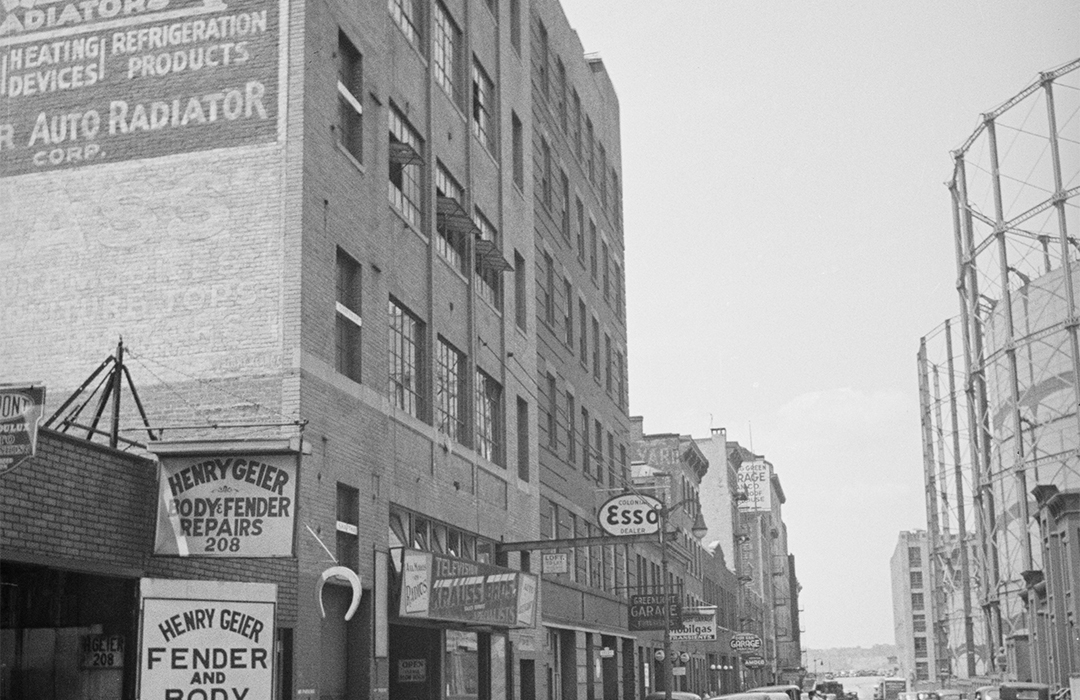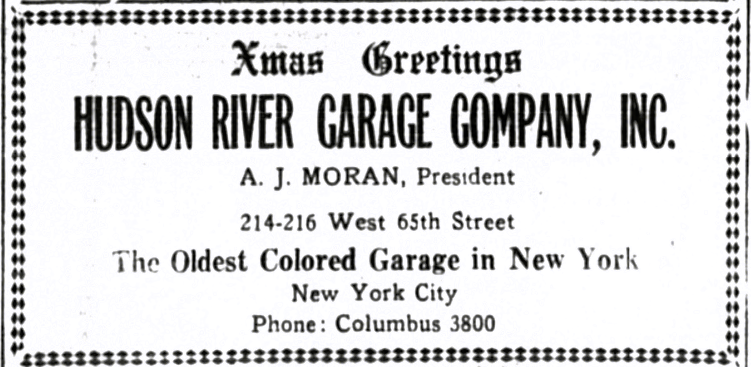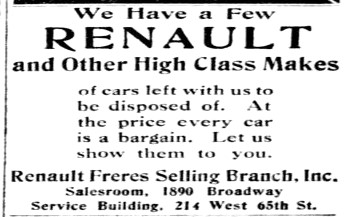
214-216 West 65th Street
by Tom Miller
On June 29, 1907, the Real Estate Record & Builders’ Guide reported, “Two buildings will be demolished at Nos. 214-216 West 65th st, on which Daniel McCoy…will immediately erect a 6-sty brick, slate roof stable.” The term “stable” was being used in a generic sense. Sometimes called an “automobile stable,” it would be what today we know as a garage. Designed by architect Erwin Rossbach, the brick-faced structure cost McCoy $35,000 to construct, or just over $1 million in 2023.
Daniel J. McCoy and his wife Annie (who held title to the property) were not taking any risks in erecting the structure. They had leased it to the Paris-based automotive company Renault Freres before the first brick was laid. On February 27, 1908, The Automobile reported, “Paul Lacroix, general manager Renault Freres Selling Branch, New York City, announces that about March 10 he will take possession of the new six-story building, Nos. 214-216 West Sixty-fifth street, especially built for the sole use of the Renault garage, spare parts, and repair shops, and Renaut taxicab department. The garage will be for the use of Renault owners exclusively.”
…especially built for the sole use of the Renault garage, spare parts, and repair shops, and Renaut taxicab department.
In addition to housing the automobiles of Renault owners, the building held the fleet of 50 Renaut taxicabs being leased to the Motor Taximeter Cab Company (it had been recently incorporated for that purpose). Additionally, a team of 36 French-trained mechanics were on hand to service the private cars and taxis. In January 1911, Motor Field explained, “Upstairs on several floors is a miniature automobile factory where all repairs and in many instances new parts are turned out on short notice, avoiding the necessity of waiting for them to arrive from France.”
A grisly accident occurred here on December 29, 1908, when truck driver William Brudie, who worked for P. Brady & Sons, plunged down the freight elevator shaft. That afternoon, he was delivering four automobiles to the building. Three of the vehicles were unloaded with no problem. Then, according to court papers, “Brudie was helping unload an automobile from the truck and was walking backward drawing the car when he stepped into the well which had been left open and unguarded. Three other automobiles had been unloaded in the same manner and the well was closed.” Annie Brudie, the widow, sued Renault Freres Selling Branch, Inc. for “contributory negligence.”
In September 1913, Renault Freres leased space in a building in Long Island City, and shortly afterward left West 65th Street. In its January 1914 issue, The Hub reported, “John D. Cogan, until recently superintendent of the Jandorf Automobile Co., New York, has leased the property at 214 and 216 West Sixty-fifth street, where he will carry on a general automobile business and build automobile bodies for all chassis. There will also be a used car department and tire department.”
Unfortunately for Cogan, his venture soon failed. His was the first in a rapid-fire turnover in tenants. A year later, the J. J. Ascher Garage was operating from the building, and on November 27, 1916, the West Sixty-Fifth Street Garage Company signed a lease. In 1917, the Wheeler Motor Car Company operated from the address, and by 1920, it was home to West Side Auto Repairs.
In 1921, A. J. Moran leased the building for his Hudson River Garage Company, Inc. The New York Age described it as “the largest garage owned by a Negro in New York and probably in the world.” Among Moran’s employees was Joseph W. Prosser, whom the newspaper described as a “short a stocky German engineer.” Prosser had a theory, and with the financial backing of several businessmen, worked on developing his “water gas fuel” in the West 65th Street building. But on August 27, 1922, The New York Times reported that “men having expert knowledge of gas fuels, gas engines and mechanical engineering” had dismissed the fuel as costing “too much to make its manufacture commercially worthwhile.”
The New York Age described it as “the largest garage owned by a Negro in New York and probably in the world.”
But Prosser and his employer pursued another invention—a new type of burner. Just over a year later, on December 8, 1923, an article in The New York Age said in part:
About a year ago he had his new burner installed in the furnace of the six story building which the garage occupies, and all this season he had been heating this building at a very low cost, giving a better grade of heat with very little trouble…Engineers from the White Star Line, the Edison Company, and several other large companies have visited the garage and all of them declare that this system of heating may revolutionize present methods of heating and generating power.
J. Moran and Joseph W. Prosser organized the Automatic Siphon Fuel Burner Corp. with Prosser as president and Moran as vice-president. But, although the firm was looking for a plant to begin commercial manufacturing at the time of the article, it seems to have quickly failed.
By the early 1960s, 214-216 West 65th Street was home to the A & D Towing Company, Inc. It relocated to West 46th Street in August 1964. At the time, the future of the property was uncertain at best. It sat within the Lincoln Square Renewal Project, first envisioned by Robert Moses in the 1950s. Dozens of buildings around the garage were demolished until, finally, 214-216 West 65th Street was razed to make way for the Fiorello LaGuardia High School of Performing Arts in 1984.
Tom Miller is a social historian and blogger at daytoninmanhattan.blogspot.com




